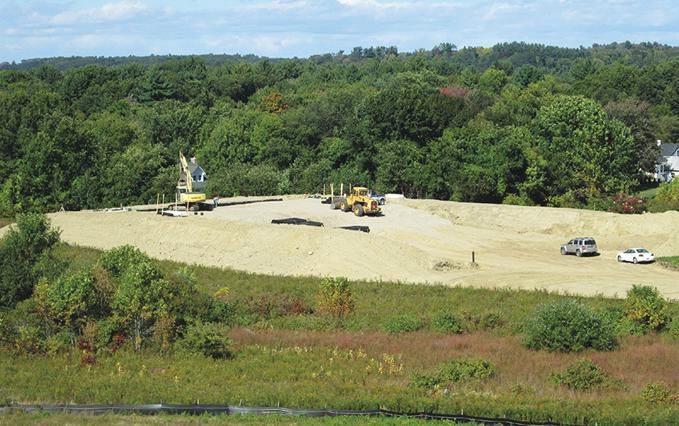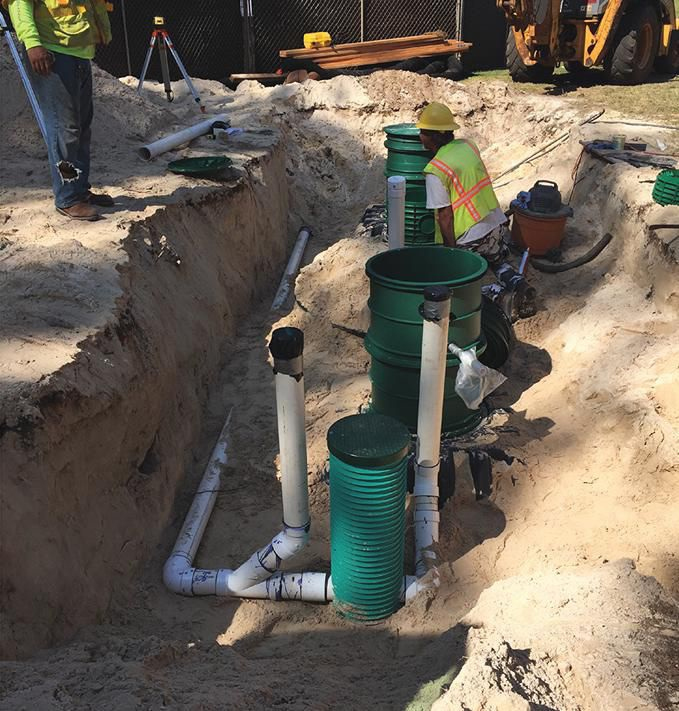Decentralized Wastewater Treatment Approaches Solve Community Challenges
By Dennis F. Hallahan
Decentralized systems are proving their value beyond traditional use in rural settings, treating larger volumes of wastewater in diverse applications while easing O&M concerns.
Communities desiring a smart growth strategy that incorporates planned residential and commercial development to support community resiliency need a solid wastewater treatment plan. Where a centralized wastewater treatment facility (WWTF) is not available, planned growth can still be a reality by incorporating cluster and individual treatment approaches and considering new technologies including aerobic treatment units (ATUs), combined treatment and disposal systems, and cluster systems.
These approaches are scalable to accommodate the collection and treatment of large volumes of wastewater onsite and then discharge of the processed effluent to the aquifer near the point of origin. The replenished aquifer can then recharge wetlands for wildlife, maintain base flow, and in the case of coastal cities and towns, counteract saltwater intrusion.
While decentralized systems have and will continue to serve the rural areas outside city limits, the notion that the decentralized system is only there to serve small, single-family homes has been transformed with large decentralized systems handling flow rates more than 1 MGD. Businesses and communities no longer need to wait for a centralized option to grow and are finding that the decentralized approach offers the performance they need at a price tag they can afford.
Decentralized Shines In Replacing Or Rehabilitating Outdated Wastewater Systems
Communities are increasingly turning to advanced, alternative decentralized wastewater treatment approaches to replace or rehabilitate outdated onsite septic systems, such as cesspools or direct discharge systems, and to eliminate surface discharge and nitrogen pollution in watershed areas. The growing awareness of nutrient damage from nitrogen and phosphorus by old or failing wastewater treatment systems is catalyzing engineers to develop decentralized applications using new technologies that can be installed cost effectively to preserve local water resources.
Advanced Treatment And Design Options
Aerobic Treatment Units (ATUs)
ATUs use many of the same processes as a municipal treatment facility but on a smaller scale. Providing a suitable environment for micro-organisms to treat wastewater is what ATUs are all about. These pre-engineered, advanced wastewater treatment systems are effective alternatives in system designs where space restrictions are an issue. Often, ATUs are also applied on sites with poor soils, shallow vertical separation distances to limiting conditions, and horizontal setback restrictions. These systems can also be designed for the treatment of high-strength wastewater or where total nitrogen removal is required.
An aerobic system injects oxygen into the treatment tank. The additional oxygen increases natural bacterial activity within the system that then provides further treatment. Whether in a residential or commercial system, the system choice and design are key to the longevity and sustainability of the ATU. Some aerobic systems may also have a pretreatment tank and a final treatment tank including disinfection to further reduce pathogen levels. In addition, having a good site plan, installation guidance, a plan for educating the customer, and a strategy for O&M is very important. Implementing O&M access points into the design will help keep it sustainable.
Combined Treatment and Dispersal Systems
A passive approach to onsite wastewater treatment, combined treatment and dispersal systems treat and disperse wastewater in the same footprint without electricity or replacement media. They perform well on difficult sites where slopes or the need to work around existing landscape present a challenge. In these systems, an ecosystem of aerobic and anaerobic bacteria digest up to 99 percent of wastewater contaminants, and then the clean water is returned to the environment. These systems take advantage of the vast capacity of soil to remove or transform pollutants that are in the effluent as it percolates through the soil, thereby avoiding point discharges to surface waters and maintaining the quality and quantity of our groundwater.
Cluster Systems
A cluster system approach can be used for a group of residential dwellings or in a mixed-use development. It comprises some form of common ownership that collects wastewater from two or more dwellings or buildings and conveys it to a treatment and dispersal system located nearby. Cluster systems are common in rural subdivisions and allow for a phased-in approach to community development. Different collection, treatment, and dispersal designs and technologies can be employed depending on the number of homes or businesses in the cluster, the strength of the wastewater produced, and the estimated daily flows.
Preventative maintenance is important with the cluster approach because an overloaded septic tank or malfunctioning pump at one connection could affect other parts of the system. Communities often hire a maintenance technician to ensure that the system is maintained and operating properly. Following treatment, effluent from cluster wastewater systems can be discharged via surface or subsurface disposal methods.
Professional Management And Remote Monitoring
Communities and developers recognizing the need for advanced wastewater treatment systems of a scale that will support positive development also recognize and often require these systems to be professionally managed. Professional management provides more control on the quality of the waste treatment process.
Remote monitoring may have a place in managing decentralized onsite systems and community systems that are too small to have onsite operators present. Advanced onsite monitoring systems typically use control boxes that can turn electric pumps on and off, monitor septic tank levels, and sound an alarm when an unusual condition occurs. Remote monitoring can also be used by sending a signal from the system to a central monitoring office. Some remote monitoring includes interactive communication that enables offsite control of pump dosing and system operations.
Decentralized Community Project Examples
Developers of Innovative Community Choose Alternative Technology to Handle Wastewater
One of the most pressing problems with a lack of centralized wastewater capacity is its effect on development within the community the facility serves. However, in areas without a centralized sewer, market forces create innovative solutions enabling unique development opportunities. Such is the case in West Newbury, MA, located near the coast in the northeast corner of the commonwealth. The Cottages at River Hill project was developed as a “pocket community” of 30 single-family homes. Rather than develop an entire property with sizable parcels and large secluded houses, pocket communities or neighborhoods concentrate clusters of smaller homes to foster community connections. This leaves most of the property as an undeveloped, shared space with walking trails, community gardens, etc., enhancing the quality of life for the residents and greater community.
It makes sense that the developers of this innovative project would choose an innovative technology for an onsite wastewater, combined treatment, and dispersal system to meet the needs of this community. This 30-home, 84-bedroom site has a design flow of 9,240 GPD. Normally, an onsite wastewater system of this size in Massachusetts would require pressure distribution to facilitate dispersal of the effluent to the native soils. However, due to the unique characteristics of this passive treatment system, the Enviro-Septic Wastewater Treatment system from Presby Environmental Inc. (PEI) has been approved for use in these applications (up to 10,000 GPD) without the use of pressure distribution for over 15 years.
The system was designed in an elevated mound configuration, due to separation to seasonal high-water table requirements for new construction. It consists of two beds for a total of 6,002 feet of Enviro-Septic pipe configured in 66 rows at 91 feet each. A portion of one of the beds (15 rows) slopes at 6 percent to allow the large field to blend in with the terrain. The Enviro-Septic system is approved for a 40 percent reduction from conventionally sized systems in Massachusetts due to the secondary treatment performance of the system. This enabled a much smaller footprint and subsequently much less disturbance to the natural areas of the property.

The system was designed in an elevated mound configuration, due to separation to seasonal high-water table requirements for new construction.
Construction of the project infrastructure and model homes began in 2014. Today, the Cottages at River Hill are fully built out and occupied. The community management association reaps the value of a low-maintenance wastewater treatment system, and the residents enjoy the benefits of a tight-knit community along with the open spaces and natural vistas this type of development provides.
Ecologically and Culturally Sensitive Community on the Coast of Hawaii Chooses Pump Vault Units and Raised Absorption Beds for Vacation Lodging Facilities
A coastal retreat community located on the shores of Hawaii needed to remove large capacity cesspools that serviced their vacation lodging facilities. The goal was to replace them with a technology that provided improved water quality to protect beaches on the waterfront enjoyed by approximately 500,000 recreational users annually. Sensitive ecological constraints and stringent regulations were top concerns, along with protecting and maintaining ancient Hawaiian burials and cultural resources.
Delta Treatment Systems designed a treatment solution that was installed at each individual lodging facility and could handle a combined daily flow of 15,000 GPD. A Delta Whitewater DF60 system was installed to service each of the 26 individual coastal cabins. The DF60 is a pump vault unit that reduces biochemical/ biological oxygen demand (BOD), total suspended solids (TSS), and ammonia with a 600-GPD design flow capacity. Wastewater discharged from the cabin flows to a 500-gallon pretreatment tank equipped with an effluent filter, then on to the Whitewater unit for biological treatment, and finally to a 500-gallon pump tank equipped with a Delta Ecofilter pump vault. The water then discharges to raised absorption beds.
The Whitewater unit allowed the community to upgrade its wastewater treatment systems to meet new standards of environmental and cultural stewardship. The discharge from the Whitewater units exceeds local regulations. The absorption beds were revegetated with a variety of native Hawaiian plants that provide aesthetic and educational benefits to guests.

Construction of one of the treatment trains. It is a view of the risers coming up from the tank openings to grade level for maintenance access.
Conclusion
Advances in decentralized wastewater treatment have provided options to communities and developers that perform, can be installed in sensitive environmental areas, and sustain desirable development vital to our communities. These alternative approaches also offer cost savings as compared to a centralized treatment solution. Each situation is unique, and the best solution for each depends on several factors and should consider the host of options available.
About The Author
 Dennis Hallahan (dhallahan@infiltratorwater.com) has over 30 years of experience with onsite wastewater treatment systems design and construction. Currently technical director at Infiltrator Water Technologies, he is responsible for technology transfer between Infiltrator and the regulatory and design communities and consults on product research and testing for universities and private consultants. Hallahan received his Master of Science degree in civil engineering from the University of Connecticut and his Bachelor of Science in civil engineering from the University of Vermont. He is a registered professional engineer in Connecticut and holds several patents for onsite wastewater products.
Dennis Hallahan (dhallahan@infiltratorwater.com) has over 30 years of experience with onsite wastewater treatment systems design and construction. Currently technical director at Infiltrator Water Technologies, he is responsible for technology transfer between Infiltrator and the regulatory and design communities and consults on product research and testing for universities and private consultants. Hallahan received his Master of Science degree in civil engineering from the University of Connecticut and his Bachelor of Science in civil engineering from the University of Vermont. He is a registered professional engineer in Connecticut and holds several patents for onsite wastewater products.
